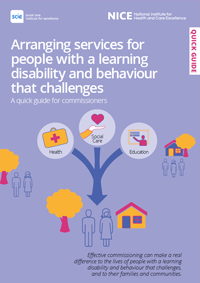A quick guide for commissioners
People with a learning disability (or autism and a learning disability) and behaviour that challenges should have the support they need to live how and where they want. Organising and developing services in the right way is the first step to making this happen.
Effective commissioning can make a real difference to the lives of people with a learning disability and behaviour that challenges, and to their families and communities.
Planning and delivering services
Appointing a lead commissioner and pooling budgets across health, social care and education, and with neighbouring authorities, is a way for local authorities and clinical commissioning groups to oversee joined up services that take a whole life approach.
The lead commissioner should have in-depth knowledge and experience of working with people with a learning disability and behaviour that challenges.
Use the following information when planning services
- How many people locally have a learning disability (including those placed out of area), and how many are likely to display behaviour that challenges?
- An analysis of the needs identified in people's education, health and care plans.
- Local registers, including those of people at risk of hospital admission, disabled children, and people referred from other teams, for example - youth offending teams and the police.
Local and regional plans should have a single care pathway and single point of access, which should be reflected in commissioning strategies.
Service planning and delivery should:
- support person-centred planning and provision
- meet the needs of people of different ages and take a 'whole life' approach
- take into account future housing and employment support needs
- be co-produced with people who use services, families and care providers
- bring together all relevant services and develop a workforce with the right skills, knowledge and qualities.

Services in the community
Community services can be structured in different ways depending on the area, for example support can be provided by one large team or several smaller teams. Overall, however, the function and aims of the service should be the same.
They should:
- support people with a full range of needs, including intensive and complex needs
- reduce the need for inpatient care for adults, chidren and young people, or residential placements for children and young people, by providing alternatives within the community wherever possible.
Community services should cover the following functions:
- advocacy
- short-term assessment and intervention
- crisis response and intervention
- specialist prevention and early intervention
- longer-term complex intervention
- quality assurance and service development
- training, information and support for families and carers to enable them to meet the needs of the person, access support from specialist services and explore short break options.
Provide information, advice and guidance for families and carers through:
- peer support
- parent and carer groups and forums
- email support
- telephone and face-to-face support
- family networks
- independent advocacy
- discussion forums
- social media groups.
Specialist support
Make sure specialist suport is available via community learning disability teams to support people with:
- behaviour
- communication
- social care and support
- physical health
- mental health
- education
- offending behaviour.
When children, young people and adults need specialist assessment and support for their behaviour, make sure it is provided within NHS waiting time standards. Set local maximum waiting times for initial assessment and for urgent and routine access to treatment and support.

Housing
People with a learning disability and behaviour that challenges should be able to live close to their friends and family. Work with local housing and social care providers to provide a range of housing and care options for people to choose from, including:
Adapting their current home.
Living alone with support.
Living with a small number of people in shared housing.
Moving outside their local area only if they want to, or this is necessary to meet their needs.
Further information
- NICE guideline: Learning disabilities and behaviour that challenges - service design and delivery.
- NICE guideline: Challenging behaviour and learning disabilities: prevention and interventions for people with learning disabilities whose behaviour challenges.
- NHS England, the Local Government Association (LGA) and the Association of Directors of Adult Social Services (ADASS) national plan: Building the right support.
- National Development Team for Inclusion (NDTi): Guide for commissioners of services for children and young people who challenge services (PDF).
- NICE/SCIE webinar: Learning disabilities and behaviour that challenges (YouTube).
- Care Quality Commission policy: Registering the right support (PDF).

Download this guide
We've created a copy of this guide that you can print and share:
Arranging services for people with a learning disability and behaviour that challenges (PDF)
This content has been co-produced by NICE and the Social Care Institute for Excellence (SCIE). It is based on NICE’s guideline on arranging services for people with a learning disability and behaviour that challenges.